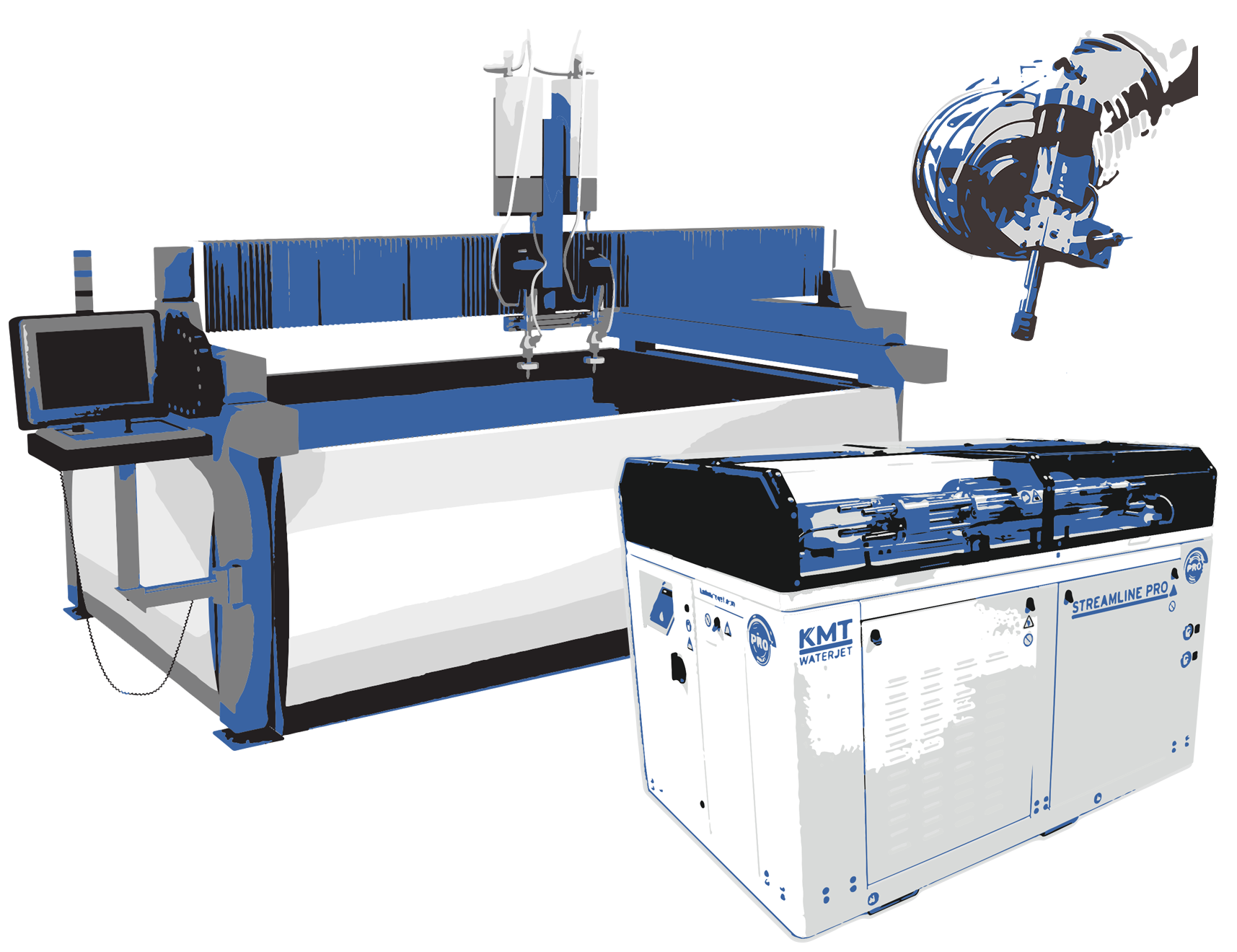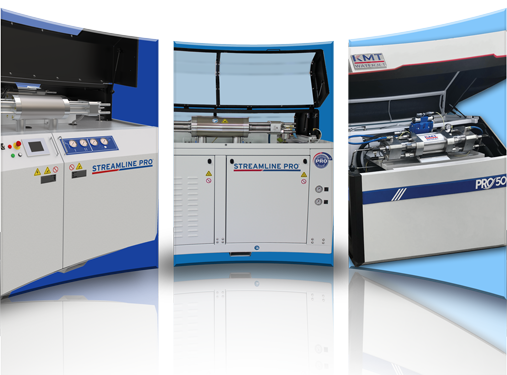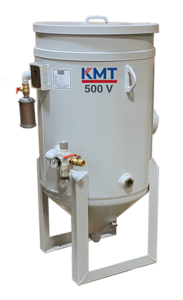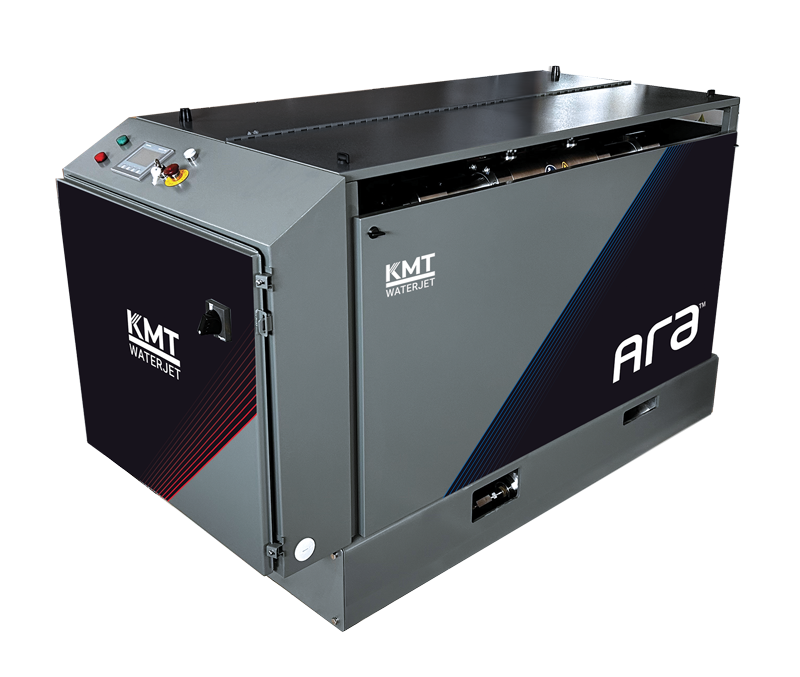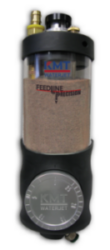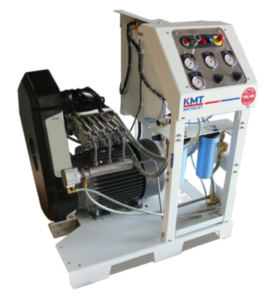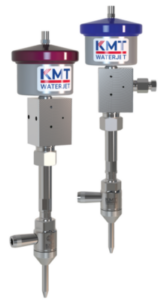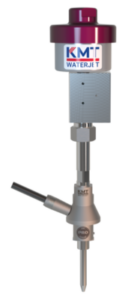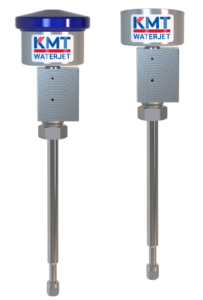We and selected third parties use cookies or similar technologies for technical purposes and, with your consent, for other purposes. You can consent to the use of such technologies by using the “Accept” button, by closing this notice, by scrolling this page, by interacting with any link or button outside of this notice or by continuing to browse otherwise.
- CUTTING SOLUTIONS
- PRODUCTS

COMPLETE SYSTEMS
KMT waterjet OEM partner machines are powered by KMT pumps ranging from 90,000 psi to 55,000 psi, with installations available in over 100 countries.

PRO 90,000 psi Pumps – World’s Fastest Waterjet
The KMT Streamline PRO® 90,000 psi Waterjet Pumps will significantly increase production by cutting in less time and use up to 50% less abrasive to produce the Lowest Cost Per Part! The PRO pump is available in three horse-powers for a wide range of cutting applications: 125, 60 and 50 HP

ADS Abrasive Hoppers
KMT Waterjet Systems ADS Series Abrasive Hoppers for Waterjet Machines are easily re-filled during the cutting process—no need to stop cutting! These hoppers are available in 2 sizes: 500 & 2,000 lb.

STREAMLINE® SL-VI 60,000 psi Pumps
KMT Waterjet SL-VI Pumps have decades of proven performance and are considered the Industry Workhorse! The SL-VI Series of pumps are available in: 15, 30, 50, 100 and 200 HP

500V Abrasive Hopper
Our 500 V Hopper precisely monitors the availability of sufficient abrasive closely during the entire cutting process and pneumatically transfers it to the onboard metering device.

KMT CLASSIC 60,000 psi Pump
The New STREAMLINE® CLASSIC Series employs long-stroke technology designed for ease of use, reliability and maximum uptime…Classic KMT with modern technology!

FEEDLINE V Abrasive Feeder
Optimized abrasive consumption for customized applications. Controlled through a central CNC controller or a potentiometer, the FEEDLINE V supplies the cutting nozzle with the optimized flow of abrasive, saving material and costs.

ARA™ 55,000 PSI PUMP
The Ara™ high-pressure pump meets all essential requirements for successful and seamless operation of a waterjet cutting system. The highly reliable intensifier design is one of the key features of the Ara™ pump and is one of the most successful and reliable KMT intensifier designs, called “HSEC”.

FEEDLINE PRECISION Abrasive Meter
The Feedline Precision Abrasive Metering System is an economical and reliable option for accurate delivery of abrasive to the cutting nozzle.

TRILINE® 55,000 psi Direct Drive Pump
The TRILINE® pump has an excellent cost of ownership value and can be used as a stand-alone unit for everyday cutting needs.

ATS Abrasive Removal Systems
Never shut down production for tank clean outs again. The all new ATS 2200 or 4400 is the perfect way to improve your waterjet operations.

IDE® Diamond Cutting Heads
The KMT Waterjet IDE® (Integrated Diamond Eductor) One-piece Assembly Cutting Head is rated for pressures up to 60,000 psi and 90,000 psi and is a waterjet nozzle breakthrough in simplicity & peak performance.

AUTOLINE® Cutting Heads
The self-aligning components of the KMT AUTOLINE® 60,000 psi and PRO 90,000 psi cutting heads provide true, perfect alignment to extend the life of focusing tubes and mixing chambers.

AQUALINE® Water-only Cutting Heads
PROVEN PERFORMANCE AT EXTREME PRESSURES! Our AQUALINE® pure water pneumatic valves have gained an industry-wide reputation for being among the quickest and the most reliable pure water cutting heads under extreme working conditions.

KMT CUT Calculator App
Compare 90,000 psi vs. 60,000 psi cutting and see how much faster you get the job done and at a lower cost per part! The KMT Waterjet Cut Calculator 2.0 App incorporates 25 materials, offers a wider range of substrate thicknesses, horsepower, orifice size, and abrasive rates.

NEO 60,000 psi Pump
The KMT Waterjet NEO Pump incorporates over 50 years of experience offering unparalleled waterjet cutting technological achievements.
- COMPLETE SYSTEMS
- ADS Abrasive Hoppers
- PRO 90,000 psi Pumps
- 500 V Abrasive Hopper
- SL-VI 60,000 psi Pumps
- FEEDLINE V Meter
- CLASSIC 60,000 psi Pump
- FEEDLINE PRECISION Meter
- NEO 60,000 psi Pump
- ATS Abrasive Removal Systems
- TRILINE 55,000 psi Pump
- IDE Diamond Cutting Head
- AUTOLINE Cutting Head
- AQUALINE Water-only Cutting Head
- Cut Calculator App
- APPLICATIONS/INDUSTRIES
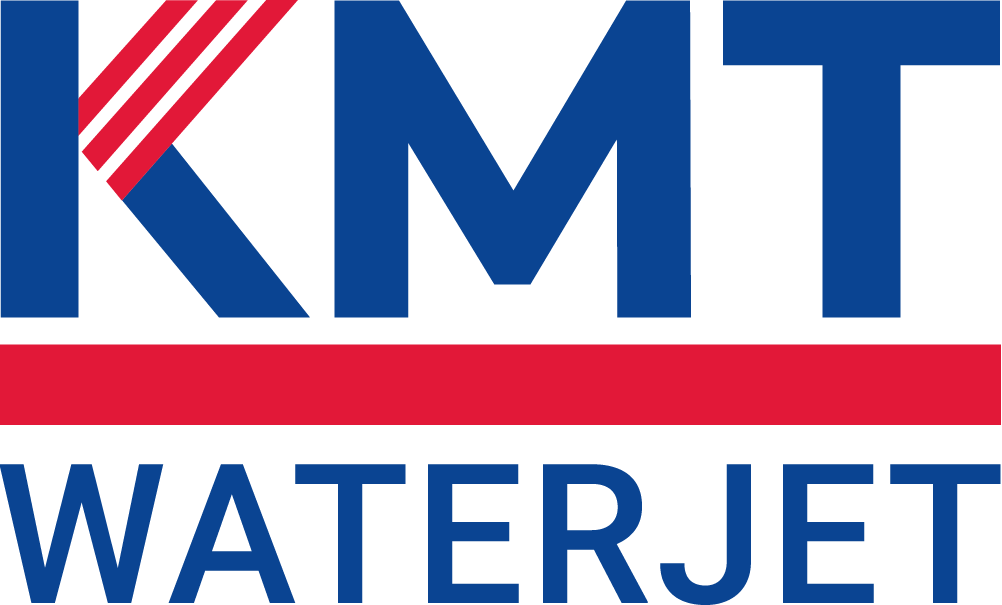
HELP CENTER
Contact form
KMT Waterjet has global offices to assist you in your region. Contact us using the following form, and the message will be forwarded to the local office which can provide the best support.
KMT Waterjet cutting plastic and acrylic
KMT Waterjet offers the best solution for cutting plastic and acrylic. With no heat-affected zone (HAZ), and no fumes, cold water jet cutting provides superior edges. No secondary finishing.
Cutting a variety of materials with KMT Waterjet technology.
Water jet cutting technology has been used for several decades to perform plastic and acrylic cutting. In fact, this process supersedes the development of the abrasive waterjet used to cut harder materials such as stone, glass, and metals. Unlike abrasive waterjet cutting, however, pure water can used to cut plastics and acrylics.
plastic and acrylic cutting. In fact, this process supersedes the development of the abrasive waterjet used to cut harder materials such as stone, glass, and metals. Unlike abrasive waterjet cutting, however, pure water can used to cut plastics and acrylics.
Waterjet technology has revolutionized plastic and acrylic cutting, surpassing traditional methods like laser and plasma. Unlike abrasive waterjet cutting, pure waterjet is used exclusively, offering several advantages:
Material Integrity: Waterjet cutting maintains material integrity, preventing water absorption and heat-affected zones, ensuring precise, clean cuts.
Efficiency and Precision: Omni-directional cutting with minimal tolerances ensures accuracy without the need for blade sharpening.
Cold Cutting: Waterjet cutting produces no heat-affected zones, preserving material integrity and avoiding melting, making it safe for plastics.
Conveyor-Fed Operation: Stationary cutting nozzles facilitate conveyor-fed operation, enhancing efficiency and automation in processing plastic and acrylic sheets.
The clean, ve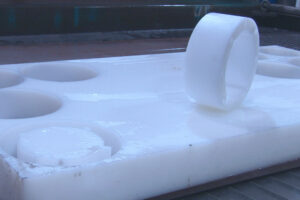 ry thin waterjet stream (thinner than a strand of human hair) does not cause the material being cut to absorb water, maintaining the integrity of the materials.
ry thin waterjet stream (thinner than a strand of human hair) does not cause the material being cut to absorb water, maintaining the integrity of the materials.
The technology also does not create heat-affected zones while precisely cutting with speed. Waterjet leaves a smooth, clean cut, virtually eliminating and second operation for finishing. Thus, the efficiency of the process makes cutting with water jets an effective solution for manufacturers of plastic and acrylic components and parts.
Overall, waterjet cutting offers a superior solution for manufacturers seeking efficient, precise, and environmentally friendly methods for cutting a variety of materials.
WATERJET CUTTING BENEFITS
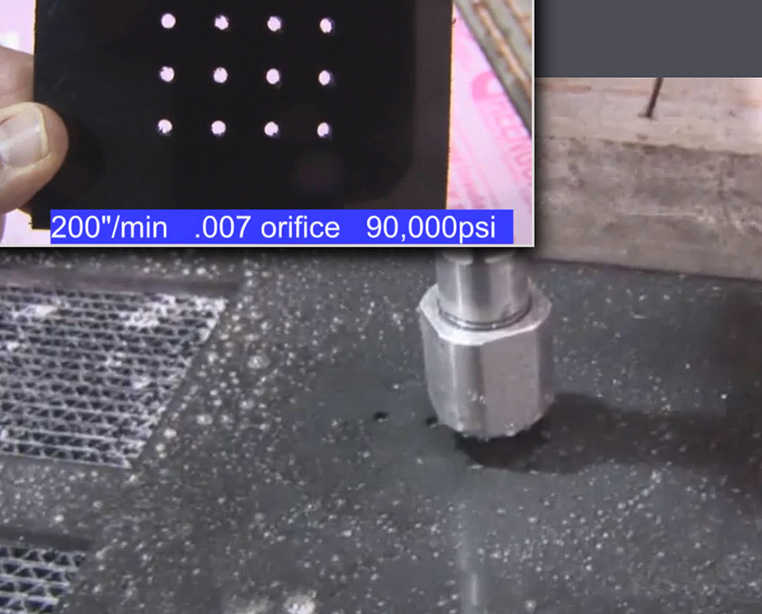
ENVIRONMENTAL SAFETY
Waterjet cutting generates no hazardous fumes or vapors, and no airborne dust, ensuring a cleaner product and safer working environment.
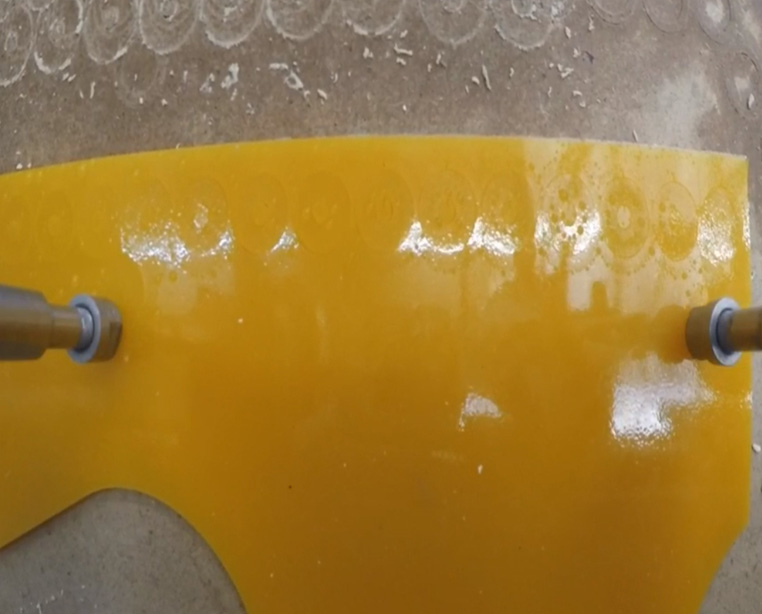
BATCH PROCESSING PLASTIC AND ACRYLIC
Multi-head waterjet systems are well-suited for batch processing, allowing for the simultaneous cutting of multiple identical or similar parts like plastic gaskets further enhancing productivity.
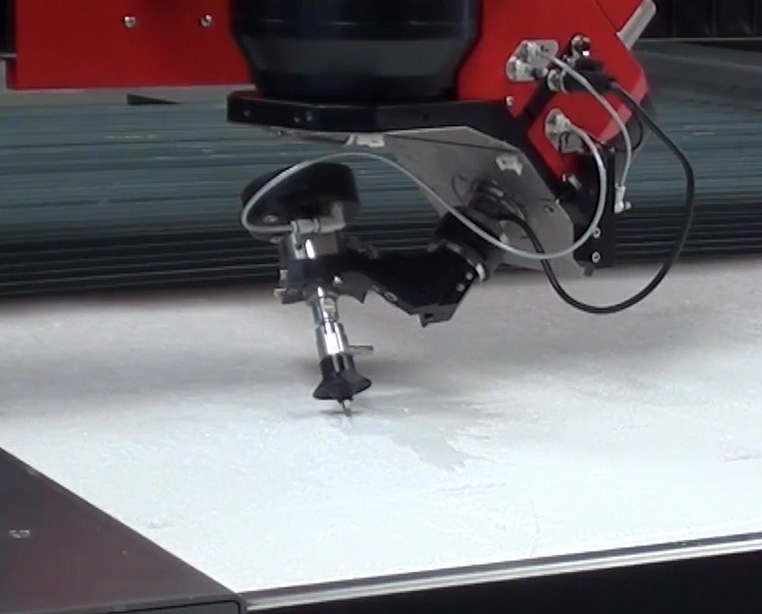
COMPLEX PLASTIC AND ACRYLIC SHAPES
Waterjet cutting is highly capable of cutting complex shapes and intricate patterns with high precision. This is particularly beneficial for plastic materials used in industries where lightweight, high-strength components with intricate geometries are required.

WATER-ONLY CUTTING
Environmentally-friendly pure water cutting doesn’t require garnet, sand, or abrasive additives and cleanly cuts up to six inches thick with no secondary finishing.
Complete Waterjet SYSTEMs for CUTTING PLASTICS AND ACRYLICS

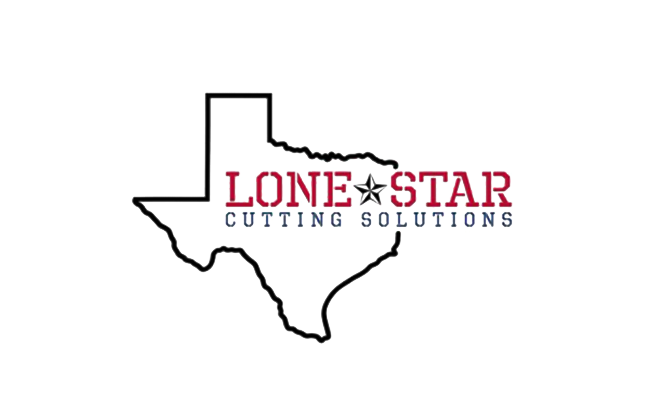
KMT Waterjet Cutting Plastic
Powered by KMT Waterjet Pumps
Waterjet cutting 3 inch thick plastic rings.

Welcome to KMT Waterjet. To continue, please select a language from the options below.

HELP CENTER
Contact form
KMT Waterjet has global offices to assist you in your region. Contact us using the following form, and the message will be forwarded to the local office which can provide the best support.
